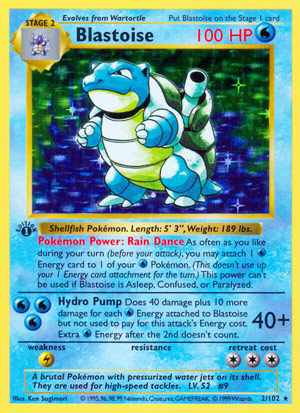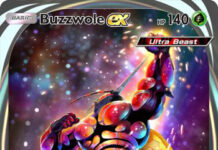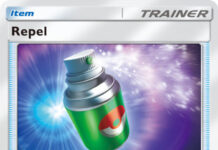
Blastoise – Base Set
Date Reviewed: October 28, 2021
Ratings Summary:
Standard: N/A
Expanded: N/A
Ratings are based on a 1 to 5 scale. 1 is horrible. 3 is average. 5 is great.
Reviews Below:

Otaku
Today we take another look at Blastoise (Base Set 2/102; Base Set 2/130). This Throwback Thursday pick is a re-review, but the original review is from February 1, 2002! Yeah, over 19 years ago. This Blastoise was our 20th Card of the Day review as a group. Well, I say “we” but this was a few years before I started reviewing. There were more than 20 CotDs before this, but that’s because it was originally just Jason “Ness” Klaczynski reviewing on his own. We’re not just looking at today’s Blastoise because it has been so long, but also because it was reprinted in a not-legal-for-tournament-play form in Celebrations. The reprint has the same set symbol (or lack thereof in this case) and numbering as the original but includes a 25th anniversary stamp on it.
Blastoise’s claim to fame is its Pokémon Power. Don’t know what those are? Think of them as Abilities before there was Abilities. They don’t count as Abilities when it comes to actual card effects or rulings, but they function more or less the same. Pokémon Powers would later be split between Poké-Bodies and Poké-Powers: effects that reference Pokémon Powers or clearly state they apply to Poké-Bodies and Poké-Powers actually affect all three. If an effect only mentions Poké-Bodies or Poké-Powers, it only affects the subset of them. Blastoise’s Pokémon Power is “Rain Dance”: it let you attach a [W] Energy from your hand to one of your [W] Pokémon as often as you wanted during your turn, before you attacked.
Originally, if Blastoise was Asleep, Confused, or Paralyzed, Rain Dance wouldn’t work. Later, when the concept of “Special Conditions” was added to the TCG, there was a general rule change or erratum (not sure how to classify it) stating that all older Pokémon with Pokémon Powers shut off by Confusion, Paralysis, and Sleep would be disabled by all Special Conditions. Meaning Poison also stopped Rain Dance from working after this ruling; before a Poisoned Blastoise could still use Rain Dance! The other relevant ruling is what you should expect from modern cards: the only thing that counts as [W] Energy while in your hand are basic Water Energy cards.
Rain Dance is an amazing Pokémon Power, even though it only works with basic Water Energy and with Water Pokémon. Blastoise is the original example of successful type support from back in the day. If you want a detailed analysis, I recommend Jason Klaczynski Retro Pokémon TCG website. As I am painfully aware, he was a competitive player when I was just a loudmouth novice fooled by beating other casual (and often much younger) players after school or at Pokémon League. Plus, human memory is quite fallible, so why not let him explain instead. What I can tell you is Rain Dance meant Blastoise was among the best decks in the Base Set, Base Set to Jungle, and Base Set through Fossil metagames.
I don’t recall Blastoise being the best, however. It was a Water type when being a Water type was good… but the Water type was competitive mostly because of Blastoise. Blastoise was a Stage 2 at a time when many players didn’t know that being a Stage 2 was a handicap, not an advantage. If you are only familiar with the rarely used Supporter version of Pokémon Breeder, was a “normal Trainer” a.k.a. what we now call an “Item card”, and it worked just like the modern version of Rare Candy. A major hurdle for Stage 2 Pokémon to clear back in the day was the Turn 1 rules and Gust of Wind (give or take a PlusPower). As the only Turn 1 restriction was “No evolving” and Gust of Wind (Boss’s Orders as an Item) was legal, as well as PlusPower and a fantastic draw/search Trainer Engine… yeah, you needed to get two Squirtle down during your first turn so that one could survive to evolve on your second turn!
Blastoise has 100 HP, which probably sounds bad but… there were no multi-Prize Pokémon for the first three to four years of the Pokémon TCG and the maximum printed HP score was 120! Throw in a metagame where doing 40 damage for three Energy was actually good and that 100 HP was as well. The card’s Achilles’ heel was its [L] Weakness. This let Electabuzz (Base Set 20/102; Base Set 2 24/130; Best of Game 1, Platinum 128/127) OHKO it… albeit with help. Electabuzz’s “Thunderpunch” attack, priced at [LC] was fast and hard-hitting way back then. It did 30 damage with a coin flip: 10 damage to itself on “tails”, or +10 damage (so 40 total) to your opponent’s Active on “heads”. Throw in two copies of PlusPower (the original printing added damage after Weakness/Resistance, not before) and it could (and did) OHKO many a Blastoise.
The lack of Resistance found on Blastoise actually seemed like a big deal back then. Resistance was -30 (like today), but with the HP scores and average damage from back in the day, it was more like it was -60 to -100 (crude estimate). With many good attackers clocking in at around 40 damage, Resistance let a Pokémon wall back in the day. At least, against that one Pokémon type. Which is also better than it sounds, as there were originally only seven Pokémon types in the TCG: Colorless, Fighting, Fire, Grass, Lightning, Psychic, and Water. The Retreat Cost of [CCC] was bad, high enough you still probably wanted to use Switch but Rain Dance meant you could sometimes afford that chunky Retreat Cost. There were no mass-Energy recycling effects, though; you had to make do with old-school Energy Retrieval (same as today, but with a one-card discard cost).
Blastoise’s attack, “Hydro Pump”, would have been bad without Rain Dance. [WWW] was even more difficult to reach back then versus now! How could that be? Energy Removal and Super Energy Removal were legal. Both were normal Trainer cards (Items); the former discarded any one Energy attached to an opponent’s Pokémon, while the latter required you discard one Energy attached to one of your own Pokémon, but then discarded two Energy from the opposing Pokémon of your choice! Rain Dance made Hydro Pump good. You wouldn’t want to rely on it all the time, as you’re risking Blastoise as your Active in order to do so, but the attack had base damage of 40 plus 10 per [W] Energy attached to Blastoise and not used to pay the attack’s Energy cost. The bonus was capped at +20. What this all means is that [WWW] did 40, [WWWW] did 50, and [WWWWW] did 60.
Again, this was good at the time. 70 damage was the magic number because most decks had a hard time doing more than 60 damage turn after turn. Yes, I’m including the competitive hard-hitting decks. You’ll see plenty of older cards hitting for more than 60 damage, but those attackers were often not that good, or were hard to keep up and running for multiple attacks in a row. Blastoise had to have five Water Energy attached and use a PlusPower, but it could do 70 damage, enough to OHKO typical Haymaker (vintage deck) Pokémon like the above Electabuzz. Haymaker decks were one of the better competitive decks for the first year or two of the Pokémon TCG… and by the end of that run, widely known. Such decks struggled if you could OHKO their line-up of mostly (sometimes exclusively) 70 HP Basic Pokémon.
Squirtle (Base Set 63/102; Base Set 2 93/130; Legendary Collection 95/110) was decent, though mostly filler. 40 HP meant it was fragile even back in the day, but if it had to be up front attacking, its first attack was “Bubble” and its second was “Withdraw”. Priced at [W] and [WC] respectively, Bubble did 10 damage and Withdraw did none, but both had you flip a coin. “Heads” meant you Paralyzed the Defending Pokémon with Bubble, while for Withdraw, it meant that Squirtle couldn’t be damage by attacks from your opponent’s Pokémon during your next turn. When you’re desperate, they’re certainly better than nothing. Wartortle (Base Set 42/100, Base Set 2 63/130) was similarly neither good nor bad. 70 HP on a Stage 1 wasn’t as good on a Stage 1, but it was still less than easy to OHKO. Withdraw could still by time, and its “Bite” attack did 40 for [WCC]. Still, many decks skipped it entirely for Pokémon Breeder.
Speaking of Pokémon Breeder, while its own Evolution line was a bit of a let down, Blastoise deck’s did have some strong combos. Super Energy Removal was less effective against Rain Dance decks, as there was a good chance the Rain Dance deck could replace the lost Energy. However, Super Energy Removal worked well in Rain Dance decks, as they could easily afford to discard an Energy from one of their own Pokémon. Yet another old card that was drastically changed when re-released was Pokémon Center. Its original text had you remove all damage counters from all of your Pokémon which had any, then discard all Energy from the Pokémon healed. Again, Blastoise decks could often (but not always) afford to replace the discarded Energy. Especially when using a Basic attacker, Rain Dance decks could use Scoop Up to bounce an injured attacker, then re-play it and attack more Energy to replace what was just lost.
As far as fellow Pokémon, in the days of Base Set-only, its primary partners were Dewgong (Base Set 25/102; Base Set 2 36/130; Legendary Collection 40/110) and/or Gyarados (Base Set 6/102; Base Set 2 7/130; Legendary Collection 12/110). Yep, Stage 1 Pokémon, and they were probably the two best even after Jungle (the second TCG set) released as well. Once Fossil (third set), was in our hands, Dewgong and Gyarados fell by the wayside: Articuno (Fossil 2/62, 17/62; Legendary Collection 2/110) and Lapras (Fossil 10/62, 25/62)gave us big, Basic attackers that hit as hard but required far effort to use. However, this set also gave us Muk (Fossil 13/62, 28/62; Legendary Collection 16/110). Its “Toxic Gas” Pokémon power shuts down all other Pokémon Powers. No Rain Dance means Blastoise’s decks risk grinding to a halt!
That is my long, rambling recollection of Blastoise, the central figure of Rain Dance decks. Since its release, many other Pokémon with similar effects have been released. Some have dominated their respective metagames, others saw little to no success. Right now, Frosmoth has inherited Blastoise’s shtick. Frosmoth may only attack Water Energy to Benched Water Pokémon but… it is a Stage 1, so far easier to run. Which also tells us that a re-release of Blastoise probably wouldn’t be very good without a significant overhaul.
Ratings
- Standard: N/A
- Expanded: N/A
We would love more volunteers to help us with our Card of the Day reviews. If you want to share your ideas on cards with other fans, feel free to drop us an email. We’d be happy to link back to your blog / YouTube Channel / etc. 😉
Click here to read our Pokémon Card of the Day Archive. We have reviewed more than 4000 Pokemon cards over the last 20 years!



